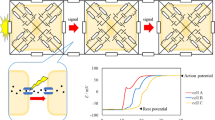Summary
Action potentials of Drosera tentacles resemble those of vertebrate peripheral nerves in that they appear to be comprised of relatively uniform spikes, variable shoulders or negative after-potentials, and variable positive after-potentials. The peaking of the spike corresponds to a period of great refractoriness, while action potentials of low amplitude may be fired readily during the negative after-potential. The action potentials fired during the negative after-potential appear to be unlike those of peripheral nerves in that they are of abnormally brief duration. Also apparently different from the case in peripheral nerves is the dependence of the duration of an action potential on the interval separating it from the preceding action potential.
Action potentials propagate from the neck of the stalk to its base at about 5 mm s-1 at room temperature. Propagation may be reversed artificially, consistent with the possibility that the neuroid cells are electrically coupled.
Similar content being viewed by others
References
Adelman, W. J., Dyro, F. N., Senft, J.: Responses obtained from internally perfused axons. J. gen. Physiol. 48, Suppl., 1–9 (1965).
Belton, P., Van Netten, C.: The effects of pharmacological agents on the electrical responses of cells of Nitella flexilis. Canad. J. Physiol. Pharmacol. 49, 824–832 (1971).
Bennett, M. V. L.: Physiology of electrotonic junctions. Ann. N.Y. Acad. Sci. 137, 509–539 (1966).
Benolken, R. M., Jacobson, S. L.: Response properties of a sensory hair excised from Venus's flytrap. J. gen. Physiol. 56, 64–82 (1970).
Burdon-Sanderson, J.: Note on the electrical phenomena which accompany stimulation of the leaf of Dionaea muscipula. Proc. roy. Soc. 21, 495–496 (1873).
Burdon-Sanderson, J.: On the electromotive properties of Dionaea in the excited and unexcited states. Phil. Trans. 173, 1–53 (1882).
Burdon-Sanderson, J.: On the electromotive properties of the leaf of Dionaea in the excited and unexcited states. Phil. Trans. B 179, 417–449 (1888).
Burdon-Sanderson, J.: The excitability of plants. In: Sir John Burdon-Sanderson, a memoir...with a selection from his papers and addresses, p. 173–198 (Burdon-Sanderson, G. et al., eds.). Oxford: Clarendon Press 1911.
Burdon-Sanderson, J., Page, F.J.M.: On the mechanical effects and on the electrical disturbance consequent on excitation of the leaf of Dionaea muscipula. Proc. roy. Soc. 25, 411–434 (1876).
Erlanger, J., Gasser, H.S.: Electrical signs of nervous activity. Philadelphia: Univ. of Pennsylvania Press 1937.
Findlay, G.P.: Membrane electrical behavior in Nitellopsis obtusa. Aust. J. biol. Sci. 23, 1033–1045 (1970).
Findlay, G.P., Hope, A.B.: Ionic relations of cells of Chara australis. VII. The separate electrical characteristics of the plasmalemma and tonoplast. Aust. J. biol. Sci. 17, 62–77 (1964).
Hodgkin, A.L.: The relation between conduction velocity and the electrical resistance outside a nerve fibre. J. Physiol. (Lond.) 94, 560–570 (1939).
Jacobson, S.L.: The ionic basis for the response to stimulation of Venus's fly-trap. Doct. dissert., Univ. of Minnesota, Minneapolis (1968).
Kishimoto, U.: Electrical characteristics of Chara corallina. Ann. Report sci. Works, Fac. Sci. Osaka Univ. 7, 115–146 (1959).
Kishimoto, U.: Repetitive action potentials in Nitella internodes. Plant and Cell Physiol. 7, 547–558 (1966).
Pickard, B.G.: Spontaneous electrical activity in shoots of Ipomoea, Pisum, and Xanthium. Planta (Berl.) 102, 91–114 (1972).
Schönherr, J., Bukovac, M.J.: Preferential polar pathways in the cuticle and their relationship to ectodesmata. Planta (Berl.) 92, 189–201 (1970).
Sibaoka, T.: Conduction of action potential in the plant cell. Trans. Bose res. Inst. 22, 43–56 (1958).
Sibaoka, T.: Acceleration of the exitatory conduction in the submerged petiole of Mimosa pudica. Sci. Rep. Tohoku Univ. (Biol.) 26, 199–204 (1960).
Sibaoka, T.: Action potentials in plant organs. Symp. Soc. exp. Biol. 20, 49–73 (1966).
Spanswick, R.M., Costerton, J.W.F.: Plasmodesmata in Nitella translucens: structure and electrical resistance. J. Cell. Sci. 2, 451–464 (1967).
Stuhlman, O., Darden, E.B.: The action potentials obtained from Venus's flytrap. Science 111, 491–492 (1950).
Umrath, K.: Über Erregungsleitung bei höheren Pflanzen. Planta (Berl.) 7, 174–207 (1929).
Umrath, K.: Der Erregungsvorgang bei höheren Pflanzen. Ergebn. Biol. 14, 1–42 (1937).
Vierhaus, J., Ulbricht, W.: Rate of action of tetraethylammonium ions on the duration of action potentials in single Ranvier nodes. Pflügers Arch. 326, 88–100 (1971).
Williams, S.E., Pickard, B.G.: Receptor potentials and action potentials in Drosera tentacles. Planta (Berl.) 103, 193–221 (1972).
Author information
Authors and Affiliations
Rights and permissions
About this article
Cite this article
Williams, S.E., Pickard, B.G. Properties of action potentials in Drosera tentacles. Planta 103, 222–240 (1972). https://doi.org/10.1007/BF00386845
Received:
Issue Date:
DOI: https://doi.org/10.1007/BF00386845




